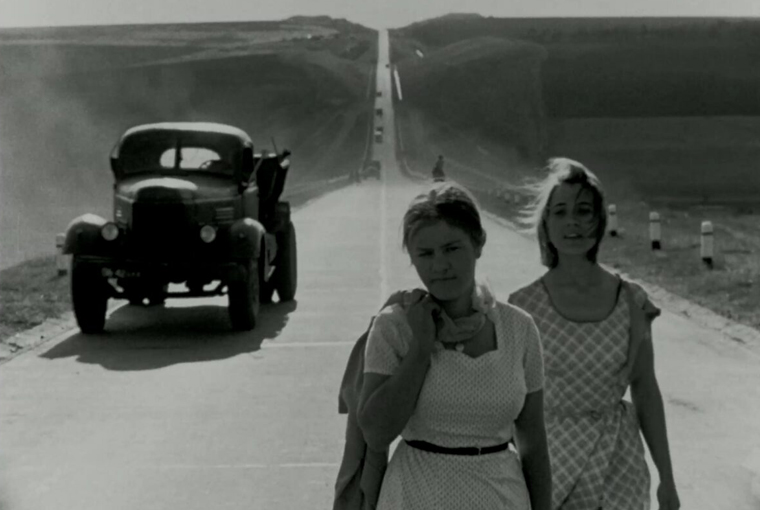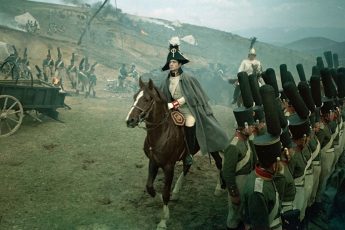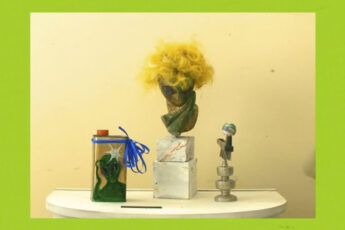The Impossibility of Love in Kira Muratova’s Brief Encounters (Korotkie Vstrechi, 1967)
Vol. 98 (October 2019) by Isabel Jacobs
In The Radicality of Love (2016), Croatian philosopher and political activist Srećko Horvat invites us to think about the radical power of love again: to fall in love, Horvat argues, is as transformative as a revolution.1 Our age of cold intimacies, sexual permissiveness and the imperative to enjoy, calls for a radical reinvention of love. Horvat’s book is a fascinating stroll through the political history of the twentieth century; we are confronted with Aleksandra Kollontai’s notion of ‘free love’, Che Guevara’s ‘love machine’, Dieter Kunzelmann’s orgasm problems and Enver Hoxha’s ban of dancing. The conclusion Horvat draws from his historical survey is that all revolutions ended in failure because they lacked a truly radical reinvention of desire. Inspired by Horvat’s claim to a radical reinvention of love, I would like to offer a new reading of Kira Muratova’s solo debut film Brief Encounters. One productive approach towards this early and still neglected work of the Ukrainian director, is to read it through the lens of revolutionary concepts like ‘free love’ and their aftermath in the Soviet society of the 1960s.
With the Bolshevik revolution of 1917, the Soviet Union was the first country to proclaim women’s complete liberation. This new gender equality seemed to require a radical transformation of desire. The early Communist utopian project cannot be separated from its radical philosophy of love: society will only be transformed through a new conception of love; Communism will be the ideal society based on the full satisfaction of erotic desire. This alignment of revolution and love is condensed in Aleksandra Kollontai’s ‘glass of water theory’: in Communism, the bourgeois model of romantic love will be replaced by ‘free love’; the satisfaction of sexual needs will then be as simple as drinking a glass of water. Soviet silent films of the 1920s, such as Abram Room’s Bed and Sofa (Tret’ia Meshanskaia, 1927) — a study of a ménage à trois in a Muscovite apartment — had dealt with the ambiguities of Kollontai’s concept of ‘free love’. After a very brief phase of erotic experimentation, Soviet authorities then claimed that by officially granting women equal political and civil rights, they had finally resolved ‘the woman question’. In the following decades, Lilya Kaganovsky argues, Stalinist cinema would likewise drown out any radical discourse on desire with “its utopian musical comedies, its grand historical films, its vicious traitors, and its epic battles for the victory of the Soviet Union.”2
By the end of the Thaw period in the mid-1960s, as the significant disparity between women’s supposed emancipation and the implementation of this freedom became obvious, Soviet cinema’s interest in the examination of desire had once again emerged. The claim that the revolution had destroyed bourgeois gender norms had turned into a justification of women’s double burden of professional and domestic work. Whether the October Revolution had really provoked a radical transformation of desire had become highly arguable. From the mid-1960s onward, women directors like Larisa Shepit’ko, Lana Gogoberidze and Kira Muratova began to deal with these questions in their cinematic works. Their critical revision of gender roles involved the exploration of a female, albeit not necessarily feminist, way of seeing. Similarly to French New Wave director Agnès Varda, Muratova aimed to make “a different kind of cinema, a different way of filming, and with that, a desire to see differently.”3 This new way of seeing is realized through Muratova’s original aesthetics, narrative strategies, the use of sound, mise-en-scène and visible camera-work.4 Her films break with Socialist Realism, whose aesthetic and ideological conventions had shaped Stalinist cinema and still remained influential during the Brezhnev era. When Muratova realized Brief Encounters in the Odessa Film Studio in 1967, she had to deal with a re-intensified culture of state intervention in the Soviet film industry.
Brief Encounters has a simple plot, yet the film is not narrated chronologically. On the surface, we are confronted with a love triangle that refers back to revolutionary concepts of free love. Valia (played by Muratova herself) is a woman in her thirties who works for the city soviet as a water inspector; she is the embodiment of the liberated Soviet woman with professional responsibility. Her husband Maksim (Vladimir Vysockii) is a guitar-playing geologist and vagabond. During one of his expeditions he starts a brief affair with Nadia — Nina Ruslanova in her debut role— a young girl from the countryside who works at a bar. Like a moth to the flame, Nadia follows the irresistible geologist to the city where she ends up in Valia’s house, not knowing that Maksim is married to her. Valia mistakes Nadia for the new house maid and they start living together. It is a rather fictional love triangle: the encounters of the two women with Maksim are presented in a series of flashbacks; these scenes constantly interrupt the narrative layer of present time which explores the women’s relationship to each other.
This retrospective narration significantly shapes our perception of the characters and their triangulations of desire. Both women are related to Maksim in a different way; correspondingly, he appears in two disparate love stories. Maksim embodies the absent and elusive man, a phantasmagoric object of both women’s desire. He never appears in real time, but only in his lovers’ memories and through the traces he has left behind. Maksim represents a certain stereotype of cowboy-like masculinity: the unattached and wild man who is ‘today here, but tomorrow, maybe, on Kamchatka.’ Maksim is a somehow empty character, only defined by both women’s projections and memories; he is never really there and yet the center of gravity in both their lives. His absence leaves behind an insurmountable void. Muratova’s use of non-linear narration mirrors the phantasmagoric character of love: the experience of love can only be captured in retrospect, love itself is never present and there is a certain impossibility of fulfilled and enduring love.
In one scene, Valia reflects on her phantasmagoric love with Maksim: “When you are not here, I always remember us sitting on this bench. But we don’t ever sit on this bench. At all.” In this cosmos, love itself does not exist, only impossible desire which oscillates between absence and waiting. Muratova transforms the theme of waiting, a “standard trope of melodrama,”5 into the existential characteristic of female subjectivity. Waiting for the absent man becomes women’s work, a burden of emotional labor; in the state of waiting, we can argue with Julia Kristeva, time is experienced in two modalities: repetition and eternity.6 Repetition refers to the cyclical return of the same activities: in Brief Encounters these are domestic as well as professional duties like washing the dishes or writing a speech about agriculture; to perform them provides neither satisfaction nor value. Maksim’s absence is experienced as an eternity “without cleavage or escape”.7 Paradoxically, we have the experience of a certain immediacy, presence and happiness only exist in retrospect, as presented in the flashback scenes. One of the shortest flashbacks, set in an aquarium, is probably the happiest moment in the film. The camera captures Valia and Maksim through the moving water, into which he has thrown a crayfish. Their faces and bodies are blurred by veils of water, which creates the impression of ephemerality and momentariness. Love and happiness, as Muratova suggests here in a Chekhovian spirit, can never be kept; their loss generates endless periods of boredom, waiting and emptiness.
A recurrent sound in Brief Encounters is the ticking of a clock, a motif referring to the experience of time as deferral and of being “always too late”8. Already the opening scene is a study on waiting: Valia toys with a pencil, absent-minded. We witness her inability to write, her aimless pacing around the kitchen; then the camera lingers on heaps of dirty dishes. In Muratova’s film, the subjects emerge through their tactile interaction with the world of things surrounding them. People and objects create a sensual system of signs, in which spectacles of subjectivity and desire take place. Plants, dishes, instruments, clothes, bed linen, walls, furniture and telephones have an almost animate presence. Both women explore the world not only with their gaze, but also through the touch of their hands. When setting her clocks, Valia seems to be establishing a sensual connection to time.
The interior in Muratova’s films, as Lida Oukaderova describes it, is overburdened with “obscure fragments” and “trivial details”;9 every object has both a material texture and symbolic significance. Muratova’s way of seeing is a corporeal and passionate engagement with the world; the characters’ emotional life and the world of things are one inextricable reality. The gaze in Brief Encounters is connected to the character’s desire: it is the lover’s gaze which experiences the world as full of signs that point to the absent object of desire. Things evoke memories through their ability to create sensual experiences. Maksim is mentioned for the first time when Valia offers Nadia some dry biscuits which he had brought from his last trip: a rather Soviet version of Marcel Proust’s madeleines.
Muratova uses several objects as symbolic manifestations of the characters’ complex triangulations of desire. It is especially Maksim’s guitar whose semiotic potential is manifold: at times the instrument points to the absent man, at times to the female body, as played on and embraced by Maksim. Before Nadia arrives in Valia’s apartment, one string of Maksim’s guitar breaks for no reason, like an omen of their love’s looming destruction. Nadia then explores the apartment; when she touches the guitar, music starts playing and the scenery changes into the bar where she encountered Maksim. The two narrative levels of present time and flashback are visually juxtaposed in montage technique and audibly connected through cross-fading sound; calm guitar music and twittering birds demarcate transitions between narrative levels. In the flashback, Nadia initiates hers and Maksim’s romance by cheekily strumming a guitar string. Maksim then forgets his guitar and Nadia runs after him to give it back. The handover of the guitar is performed like a reenactment of the fall of man, an erotic gesture of temptation and seduction. Maksim starts playing and singing, then haphazardly stops and shoulders the guitar. The scenery fades out in white.
From the women’s perspective, the guitar is a symbol pointing to Maksim’s absence. When Valia talks to Nadia about the experience of suffering without any rational reason or sense, she moves towards the guitar. The camera lingers on the instrument and Valia begins her speech when she is interrupted by a sudden cut. In another flashback, Maksim is singing and playing the guitar in Valia’s apartment. Instead of listening to what she says, he continues playing, and her voice and the music blend into each other without communicating. The difference between the lovers, as it turns out in this scene, can never be overcome; they are, as Valia puts it, like ‘plants from foreign planets’ or, in Maksim’s words, ‘from different tribes.’ The erotic encounters in Muratova’s film are literally ‘brief encounters’: they are ephemeral and always already passed moments of intimacy.
Throughout the entire film, the half-ironical play with the biblical motif of seduction continues. It is always Nadia who passes things (a bottle, a comb, a guitar and his jacket) over to Maksim and thus appears to tempt him, if unintentionally. In one scene, Nadia comes to the forest where the geologists are staying to bring Maksim his jacket. In Maksim’s workplace – primordial nature – they kiss for the first time. Like the guitar, the jacket transforms into a meaningful thing, a material symbol of desire. When Nadia introduces herself in an earlier flashback scene, Maksim plays on a comb, regretting the loss of his guitar. After a short moment of nostalgia, he then lightheartedly proclaims that he will have to buy a new one (‘Nado druguiu kupit’!’). The guitar points here to the woman he has left behind and who suddenly becomes replaceable for him. This moment marks a shift in his relationship with Valia. Nadia’s presence unveils the possibility of replacing Valia, as though it did not really matter on which guitar he played. Maksim — not to forget, played by Soviet cult singer Vladimir Vysockii — then starts singing a song that contains the line ‘Nothing is sacred!’ (‘Nichego ne sviato!’). In this constellation, Muratova confronts us with a certain discomfort regarding Maksim’s distortion of free love, which transforms lovers into replaceable objects of desire.
This scene is also very exemplary of Muratova’s creation of gazing scenarios to represent dynamics of desire. While waiting for the guitar, Maksim looks at a dog lying next to him, and the dog gazes back at him. Both man and dog show a nostalgic and painful expression. Maksim seems to think about the woman he has left behind. Nadia, in contrast, looks at Maksim with a paralyzed and simultaneously provoking gaze. He abruptly changes his gaze to a flirtatious one. The whole scenery communicates the absurd humor and subtle tragedy of human desire. Here again, ways of seeing are deeply connected to desire: Maksim aims to escape from being fixated by the female gaze. His absence can be read as an expression of his fear to be seen and thus known by the women; at one point he says to Valia that under her gaze he feels like a ‘worm under the microscope’ and asks her to only look at him ‘with loving eyes, blind ones.’ Nadia constantly observes him as well and he asks her several times to stop doing so. The women look at him in order to understand who he is. Through seeing they gain the power to subjectify him under their gaze. As Kaganovsky suggests, Muratova’s cinema is an exploration of the desire to examine human beings like worms under a microscope.10 For Muratova, desire is connected to the desire to understand, the wisdom of love: philosophy.
Brief Encounters can be read as a critical engagement with the legacy of radical concepts of desire. Muratova’s film suggests that the Soviet society of the 1960s was a long way from the utopian claim to make the fulfillment of desire as simple as a sip of water. On the contrary, archaic patterns of desire and patriarchal power structures seem to have been left untouched. Although Valia embodies the liberated Soviet woman with high professional responsibility, her desire does not seem to be liberated; she is restricted by invisible burdens, inequalities and the existential question of whether to wash the dishes or not. Maksim, however, appropriates the notion of free love to justify the lack of his sense of responsibility. His concept of freedom builds on the revolutionary claim of permissiveness in sexual relations,11 but it is a freedom that completely hinges on women’s emotional labor. Muratova does not present us a love triangle that radically deconstructs the patriarchal and bourgeois order, but rather suggests the incompatibility of an egoistic notion of freedom and true love. Sexual freedom in Brief Encounters is strictly reserved for cowboy-like men like Maksim and any transformative potential becomes completely blighted by archaic patterns of desire, in which men are absent phantoms for whom women are doomed to wait.
References
-
1.Horvat, S. (2016). The Radicality of Love. Cambridge: Polity Press.
-
2.Kaganovsky, L. (2012). Ways of Seeing: On Kira Muratova’s Brief Encounters and Larisa Shepit’ko’s Wings. The Russian Review, 71(3), 482-99.
-
3.Kaganovsky, Ways of Seeing, 484.
-
4.Kaganovsky, Ways of Seeing, 485.
-
5.Kaganovsky, Ways of Seeing, 488.
-
6.Kristeva, J. (1981). Women’s Time. Signs, 7(1), 16.
-
7.Kristeva, Women’s Time, 16.
-
8.Kaganovsky, Ways of Seeing 488.
-
9.Oukaderova, L. (2017). The Cinema of the Soviet Thaw: Space, Materiality, Movement. Bloomington: Indiana University Press, 150f.
-
10.Kaganovsky, Ways of Seeing, 489.
-
11.Kristeva, 21.




Leave a Comment